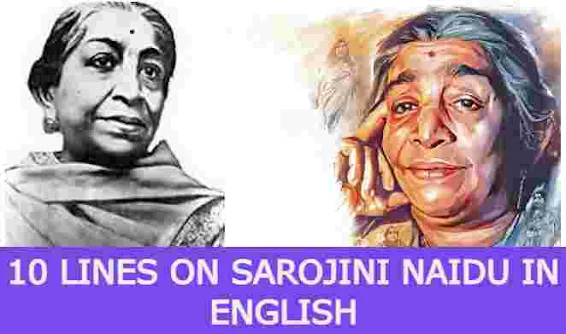10 Lines on Sarojini Naidu in English
1. Sarojini Naidu was a freedom fighter and a poet.
2. Sarojini Naidu was born on February 13, 1879, in Hyderabad.
3. Sarojini Naidu was known as 'The Nightingale of India ' because of her poems.
4. She was active in Mahatma Gandhi's Non-co-operation movement.
5. she was the first Indian woman to become the President of the Indian National Congress.
6. Sarojini Naidu was the first woman to become the Governor of a state of India.
7. She was jailed several times for Nationalist activities.
8. She has been actively involved in civil rights and women's emancipation.
9. Sarojini Naidu died on 2nd March 1949 due to a heart attack.
10. Her birthday is rightly Celebrated as 'National Women's Day' in India.
10 Lines on Sarojini Naidu in English
1. Sarojini Naidu was a poetess and as well a freedom fighter.
2. She was born on 13th February 1879 in a Bengali family in Hyderabad.
3. Her father's name was Aghorenath Chattopadhyay and her mother's name was Barada Sundari Devi.
4. Sarojini Naidu cleared her matriculation and moved to London for higher studies.
5. She was brought into politics by Gopal Krishna Gokhale, Gandhi and Nehru.
6. She became the President of the Indian National Congress in 1925.
7. She also actively worked hard for the upliftment and equality of women in society.
8. Sarojini Naidu's birthday is celebrated as National Women's Day of India.
9. She was also known as the Nightingale of India due to her poetic qualities.
10. Sarojini Naidu died on 2nd March 1949 while serving her Governor of State position.
10 Lines on Sarojini Naidu in English
- Sarojini Naidu was a freedom fighter as well as a poet.
- She was born on 13 February 1879 in a Bengali family in Hyderabad.
- She was also known as the nightingale of India due to her poetic qualities.
- She awakened the spirit of the freedom struggle of India through her poems.
- She was very brilliant since her childhood and started writing poems from a very young age.
- In 1916 Sarojini Naidu took inspiration from Gandhiji and decided to fight for freedom
- She was appointed as the president of the Indian national congress.
- In 1925 and later became the governor of the united provinces in 1947.
- Naidu's poetry includes both children's poems and other returns to more serious themes including patriotism romance and tragedy.
- She was awarded Kesar a hill medal for her social services she passed away on 2 March 1949 at Lucknow Uttar Pradesh.
10 Lines on Sarojini Naidu in English
- Sarojini Naidu was born on 13th February 1879 in Hyderabad
- Sarojini Naidu's birthday is celebrated as the national women's day of India every year
- she was an Indian political activist and poet Sarojini Naidu also known as the nightingale of India or Bharat Kokila because of her poems.
- Her writing style is traditional and Simple.
- She participated in the Indian national movement for the independence of the country
- Sarojini was very intelligent and at the age of 13, she returned a poem called the lady of the lake.
- She was the eldest daughter of her parents
- She was appointed the president of the Indian national congress in 1925. because of the knight's political and educational abilities.
- After that, she went to South Africa as the representative of India in 1932.
- Sarojini Naidu was the first woman to become the governor of the state of India.
- Naidu was governor of Uttar Pradesh from 15 august 1947 to 2 March 1949.
- she died of a heart attack on March 2 1949 while working in her office in Lucknow.




Comments
Post a Comment